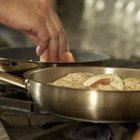
Wings, thighs, breasts -- even the whole chicken -- no matter which part of the bird you are baking, the internal temperature needs to reach 165 degrees Fahrenheit before it is safe to eat. If the chicken is not completely defrosted before baking begins, it will take longer to reach this temperature. Even if you've set your oven timer for the extended baking, a meat thermometer pressed into the chicken ensures it's cooked through.
Time Plus 50 Percent
Whether you cook parts or a whole chicken, baking from the partial or completely frozen state means you need to cook it longer. Chicken that is not thawed before it hits the oven requires 50 percent more time to cook. In other words, if chicken usually takes two hours to bake in your oven, plan on three hours for a frozen bird.
Before You Freeze
Whole chickens often contain a bag of giblets stuffed inside the cavity. The bag contains the heart, liver, gizzard and sometimes the neck of the bird. Remove this bag before cooking or freezing. Removing the giblets before freezing the chicken ensures you do not bake the chicken with the bag inside. Reach inside, pull out the giblet bag and freeze it separately from the chicken or throw it out.
Thaw It Right
Never defrost chicken on the counter. A chicken defrosting at room temperature is a breeding ground for illness-causing bacteria. The safest way to defrost chicken is in the refrigerator where the low temperatures prevent bacteria from multiplying. Take the chicken out of freezer the night before baking. Even if it is not completely defrosted by the time you plan to start baking, you can still do so as long as you allow for the extra cooking time.
Skip the Microwave and Slow Cooker
Some recipes call for baking chicken in the slow cooker or microwave -- neither of which is safe to use for chicken that is not fully defrosted. While it is safe to bake frozen chicken in a conventional oven, the slow cooker and microwave do not produce the heat necessary to kill bacteria that develop as the frozen chicken thaws to room temperature and then heats to a safe internal temperature during the cooking process.
Related Articles

How to Defrost a Chicken in a ...

How Long Can I Keep Frozen Whole ...

How to Make Crock-pot Chicken

How to Soak Chicken in Cold Water

Can I Cook Chicken That's Been Thawed ...

How to Bake Frozen & Prebreaded Chicken

How to Bake Pre-Marinated BBQ Chicken

Can I Cook Chicken Two Weeks After the ...

How to Par-Cook Chicken Before Frying
Can You Cook Frozen Chicken?

How to Bake Boneless Chicken to Stay ...

Quick Ways to Cook Frozen Chicken

How to Marinate Roast Chicken

Can I Cook a Chicken Five Days After ...

Can I Start Marinating While My Chicken ...

How Long Can You Keep Cooked Chicken ...

How Long Can Cooked Chicken Be ...

Can I Stop Cooking a Chicken Halfway & ...

Can I Make a Roast From a Frozen State?
Is It Safe to Leave a Turkey at Room ...
References
Writer Bio
Jonae Fredericks started writing in 2007. She also has a background as a licensed cosmetologist and certified skin-care specialist. Jonae Fredericks is a certified paraeducator, presently working in the public education system.
Photo Credits
Eising/Photodisc/Getty Images